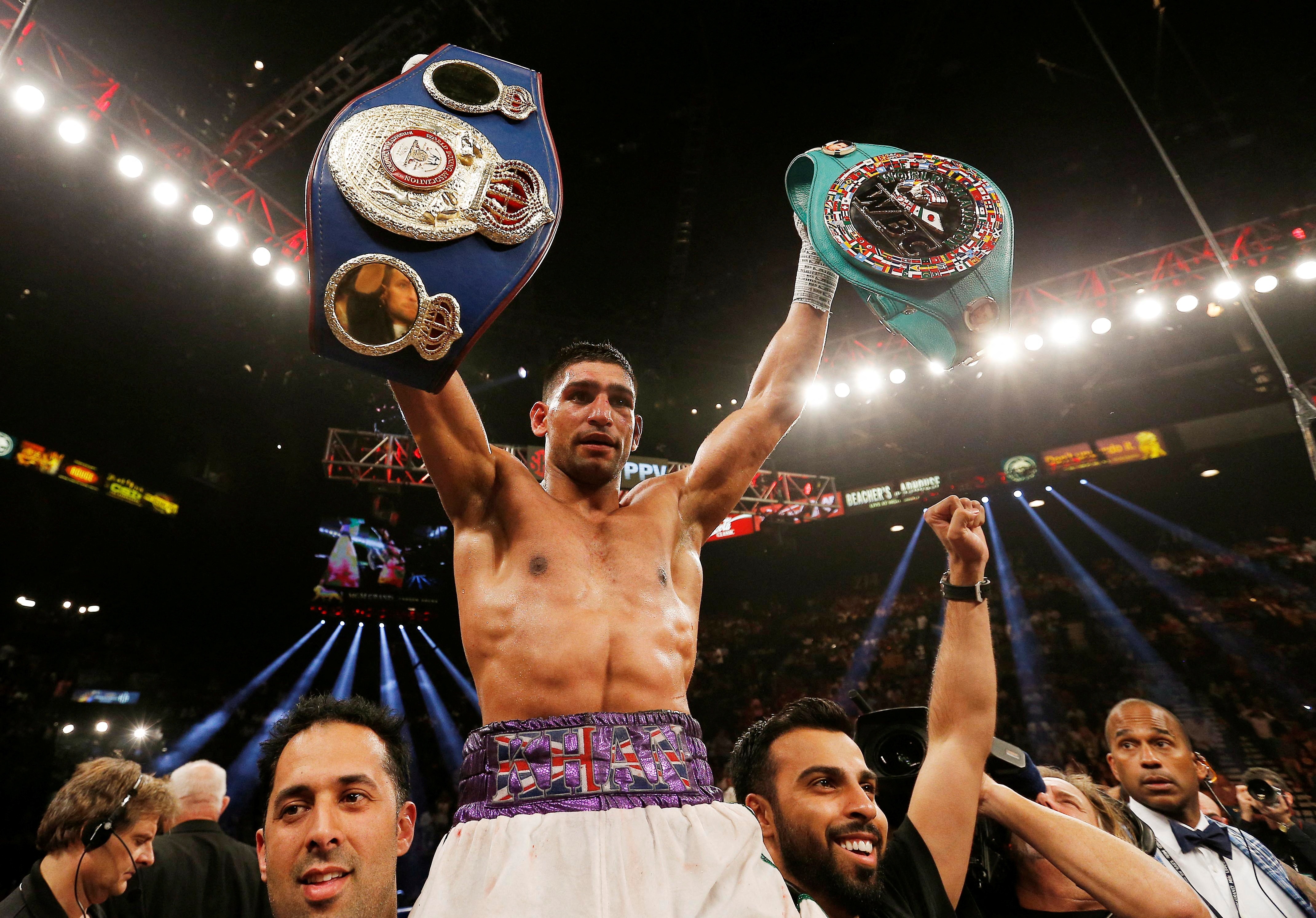ADAM AZIM wants to be the scarred face of boxing’s battle against ADHD.
Slough’s 20-year-old lightweight ace has a mush covered in battle wounds but none from his glittering amateur career or 7-0 pro start.
Adam Azim is hoping to shine a light on boxing’s battle with ADHD
Adam Azim is the next big thing in British boxing despite his childhood fight with ADHD

Adam Azim hopes to emulate his hero Amir Khan, pictured, and become champion
Every dent, scrape and blemish is the result of his Attention Deficit Hyperactivity Disorder causing him to crash into or fall off of something in his accident-prone childhood.
But – in a story that’s similar to that of 35-year-old idol Amir Khan – boxing was the perfect sport for Azim to channel his relentless energy into and beat his bad boy tag.
At Shane McGuigan’s Leyton gym, where he trains alongside welterweight brother Hassan, Azim told SunSport: “Everybody thinks the scars are from boxing but not one of them are, I was just always crashing into things and hurting myself.
“It took a long time to be diagnosed properly, I was just thought of as a naughty boy but my dad helped me use my energy in sports like kickboxing and then boxing and thankfully I have never needed any medication.
“They tried me at cricket first and I liked the batting and bowling but standing out in the field for ages was impossible for me.
“I know Amir has a similar story, his parents sent him to the gym as he was so energetic, and it must have been harder for him to handle as there was a lot less understanding of hyperactivity.
“Even ten years ago with me people didn’t understand what was happening but hopefully I can show any other children suffering that ADHD can be a gift that you can turn to your advantage.”
Much like Bolton icon Khan, who won silver at the 2004 Athens Olympics aged just 17, Azim has frighteningly fast hands.
CASINO SPECIAL – BEST NEW CUSTOMER SIGN UP DEALS
They also share Pakistani heritage and Khan’s path from Asian outcast to world champion and British national treasure is one Azim aspires to.
After capping his breakout year with a headline slot on Sky Sports beating Rylan Charlton at Ally Pally, he said: “Amir is the only British-Pakistani world champion in history and I want to be the next one.
“Amir has very kindly said in some interviews that he thinks I can do it so that is a huge motivation for me as well.
“I was in Birmingham 15 years ago to watch Amir win against Michael Gomez, my dad took me and there is a photo of us ringside.
“So it feels like a completed journey, it feels like this was meant to be and I cannot wait to grab the opportunity and make it the start of a great career.”
McGuigan’s gym is a hotbed of young British talent with siblings Daniel and Caroline Dubois also in the ranks.
And Azim revealed to SunSport that he and 20-year-old lightweight Caroline played crucial parts in improving each other over a decade ago.
He explained: “Me, Caroline and Daniel all started at the same great amateur gym, Dale Youth, when we were kids.
“Aged around eight and nine, me and Caroline actually used to spar each other.
“I have seen that when she first started boxing at another gym, she had to pretend to be a boy called Colin, but the Dale was happy to have female fighters and she was Caroline there.
“I remember the very first day she came down and I trained alongside her, I told my dad that was going to be very special.
“All these years later I am back training alongside her and Daniel and my brother every day.
“It’s a really exciting time for all of us and for British boxing hopefully”.
Frequently Asked Questions
What is the difference of a left-hook and a right-cross?
A left-hand hook is thrown on the side of a body while a lateral cross is thrown on the front.
A left hook is thrown with the back of the hand facing the opponent’s face. The elbow is bent 90°, and the wrist is turned 45° towards the opponent.
A right cross is thrown with the palm facing the opponent’s face and the elbow straight. The opponent’s wrist is rotated 45 degrees to the side.
How long does it take to learn boxing?
It takes about 3 months to learn boxing. This includes learning how to do footwork, stand, and balance. It’s important that you remember that boxing doesn’t only involve throwing punches. You need to learn how you can block and dodge attacks.
How can you learn to box punch?
A punching bag can be used to practice boxing punches. Once you feel comfortable with the technique, you can punch the bag. Next, you’ll move on to the next part of your body. Once you feel comfortable with one area, you’ll move on to the next.
What are the health benefits of boxing
There are many benefits to boxing. Boxing builds strong bones and muscles. Boxing can improve your coordination and reflexes. It can also help strengthen your heart muscle and lungs. The best thing about boxing is that it doesn’t require any special equipment. You can use whatever you have around the house.
How long does it take to learn to box?
Boxing is one the oldest forms of martial arts. China recorded the first boxing match in 2200 BC. Since thousands of years, boxing is a well-known sport. Boxing is still very popular with celebrities and athletes. It takes approximately 10 months to master boxing.
It is difficult to learn boxing because there are so many movements. Each movement requires a specific set of muscles to work properly. It takes time and effort to build these muscles.
You can learn how to move your body and then you can begin practicing any type boxing technique. Each technique will become easier over time.
Statistics
- You want to be running at roughly 75-80% of your top speed..5 mile slow, easy recovery jog at the end.[6]X Research source 2Mix in long runs, shadow boxing, and short sprints on non-interval days. (wikihow.com)
- It is just like normal sparring with a partner, but you want to throw punches at 75% of your normal speed. (wikihow.com)
External Links
boxandflow.com
en.wikipedia.org
How To
These are the basic skills of boxing
How to box effectively
Boxing has become a very popular sport. It consists of two opponents who try to knock out each other’s head. Boxing rules vary from one country or another. In general, there are three types of boxing; Amateur, Professional and Olympic boxing.
Amateur boxing is usually practiced at school, college or university. This boxing style includes sparring sessions without protection, using padded gloves. Amateur boxing matches usually consist of three rounds lasting five minutes each. There are many types of amateur boxing: Kickboxing, Muay Thai and Taekwondo.
Boxing is typically practiced in clubs, stadiums or gyms. They use protective equipment, such as mouthpieces, nose guards, shin protectors, elbow pads knee pads, waist belts and groin protectors. Professional boxing competitions include six rounds of four minutes each. There are many styles to professional boxing.
Olympic boxing is done at the Olympics. International standards require that boxers use special protective gear. The competition lasts for eight rounds, each lasting three minutes. Olympic boxing can be divided into two types: Light Flyweight (Heavyweight) and Heavyweight (Light Flyweight).
These are the basic skills required to box.
- Punching techniques
- Guarding techniques
- Footwork
- Stance
- Move your body
- Defense
- Combination
- Rotation
- Spare parts
Punching Techniques
There are seven kinds of punches: Left Hook, Right Hook, Uppercut, Cross, Straight, Overhand and Underhand. Each punch is different. Some punches need more power than others. For example, an uppercut is a powerful punch. A straight punch, on the other hand requires less power and is quicker than other punches.
There are also different combinations. These are combinations which combine several punches in order to achieve a specific goal. A combination can contain multiple parts. A left hook followed with a right-cross will cause injury to the opponent’s jaw.
Guard Techniques
To defend himself from being attacked, a boxer uses his entire body. He uses his arms, legs, elbows, knees, knees, and feet to do this.
Legs
Boxers must use their legs to defend themselves against kicks. After receiving a kick, he will raise his leg and move away from the attacker. If the attacker is coming from the front, he will bend at the knees to avoid getting kicked on either side. If the attack is from the side, he will bend his knees to avoid being kicked on the side.
Elbows
Because they inflict pain, elbow strikes can be very effective. An elbow strike can be delivered either directly or indirectly. Directly means you hit your opponent directly with your forearm. While indirectly, it means you hit him with another section of your arm.
Hands
Boxers use both their hands and arms to prevent incoming blows. Boxers raise their fists to block incoming blows and then move in the direction of the attacker’s attack. They then make contact with their attacker’s fist.
Knees
Boxers who are subject to a punch to their stomachs, abdomens, or chests should bend at the knees to absorb the impact. For defense purposes, knee strikes are common.
Feet
If he is being attacked, a boxer must take a step back and counter-attack. This will help him gain distance from his opponent. Also, boxers must maintain their balance while delivering counter-attacks.
Stances
In order to box effectively, a boxer needs to establish a stance. The way he defends himself will be determined by his stance. It defines where he faces his opponent and how he positions his body. Boxers can take many different stances. Here are the most commonly used ones:
- Low stance
- High stance
- Southpaw stance
- Western stance
The Body Movement
A boxer must be able to move around his opponent in order to win a fight. This requires changing your position, speed, and rhythm.
Rotation
To increase his punching power, a boxer rotates when he throws a punch. You can rotate at different speeds depending upon the punch.
Combinations
The timing of each punch will determine the effectiveness and efficiency of a combination. A combination of strong and weak punches will produce a good result.
Spare parts
Sparring is a practice session designed to improve boxing skills . Sparring is a training session that helps a boxer train his mind and body. The purpose of sparring is, in short, to learn how fight and not get hurt.
It is important to be patient and dedicated when learning how to box. To be a better boxer you need to train hard.

